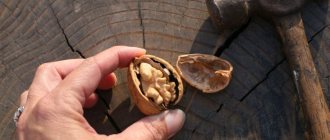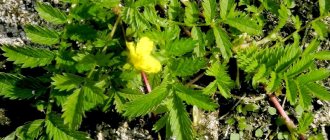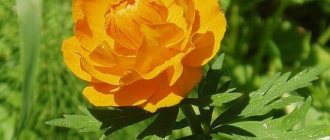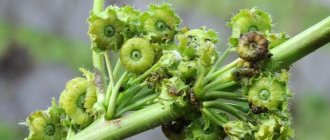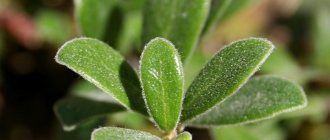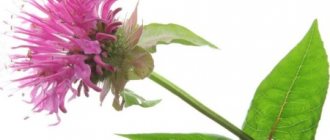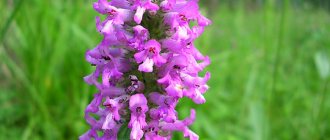Vegetable growing » Cabbage
1
1486
Article rating
Kira Stoletova
Hare cabbage is a perennial plant belonging to the Crassulaceae genus. It grows on sandy soils. You can find cabbage near bodies of water, along roads, where it merges with bushes.
Medicinal properties of hare cabbage
What does hare cabbage grass look like and where does it grow?
The succulent belongs to the Tolstyankov family. The medicinal plant has the following name options:
- hare cabbage;
- squeaky grass, as well as live, feverish, hernia grass;
- purple sedum or sedum;
- young.
The low plant is formed by several stems and fleshy, dense leaves. The color of the flowers varies and depends on the variety. Purple sedum got its name due to its characteristic color.
The adventitious roots of the plant are superficial. They don't lie deep. It is noteworthy that the main root is missing. Dense erect stems reach 65 cm in height. The lush leaves are usually oval in shape and have a maximum length of 8 cm. The green plates of the plant are thickened. Small flowers are represented by inflorescences that are framed by upper leaves.
Hare cabbage is common in almost all countries in Eurasia. The medicinal plant is not found only in the Arctic. Grass is better known as a garden crop.
The growing area of purple sedum includes:
- areas adjacent to lakes and rivers;
- forests;
- meadows;
- steppes.
Important! The hare cabbage plant, the photo of which is located below, is known for its numerous beneficial properties.
Purple sedum is a honey plant
The flowering period begins in mid-July and lasts until the first frost.
Chemical composition
Purple sedum is popular in folk medicine due to its healing properties. They are caused by a set of unique substances that make up the plant’s raw materials:
- alkaloids that have a beneficial effect on the nervous and circulatory system;
- ascorbic acid, which supports immunity;
- saponins, which help regulate the functioning of the entire body;
- sugar, which supports brain function;
- group B compounds that improve overall well-being;
- retinol, which increases visual acuity;
- calcium, necessary for bone strength;
- magnesium, recommended for the prevention of diseases of the nervous and digestive systems;
- iron, which prevents the development of anemia.
Sedum is also a source of the following substances:
- ash;
- tannins;
- wax;
- essential oils;
- coumarins;
- cholecalciferol;
- tocopherol
Important! Products made from purpurea sedum increase performance and normalize the functioning of various organs and systems.
Where is sedum planted?
Sedum can be grown both outdoors in the garden and in a pot on the windowsill of an apartment. Only for each of these purposes different types of sedum are used, and accordingly their care differs .
In the open ground
For cultivation on the site, both upright and ground cover species . They can be used to decorate borders, rock gardens or just flower beds.
Tall plants are successfully used as borders, which can divide the area into functional zones. In this case, simultaneous planting of sedums with flowers of different shades nearby is allowed. The distance between individual bushes is maintained around 20-30 centimeters .
Sedums of both types are planted in flower beds. Gardeners especially appreciate their neutral attitude towards atmospheric pollution.
Sedum is accustomed to arid and rocky places, and therefore can be used with great success in rock gardens. It can successfully fit into an alpine hill, slope, or simply into a flat rocky area.
Caring for sedum growing in the garden is not very difficult. Varieties pressed to the ground can be planted on soil poor in minerals. Tall flowering plants do better in a nutrient mixture. The place must be chosen so that it is well lit , and in the fall the plant is not covered with leaves from the tree, since in the spring the sedum will not be able to grow through their layer.
Sedum tolerates the winter of central Russia well; in more severe areas it should be covered. In spring, the plant must be rejuvenated a little, old and dried shoots are cut off, and fertilizer is applied. The closest attention should be paid to the appearance of weeds next to the sedum - it does not compete well with them for space and nutrients. Therefore, it is worth regularly weeding around it. Watering is carried out moderately; water consumption increases only in hot weather or after transplantation.
Indoor sedum
For indoor growing, tropical varieties are used that grow to a small size - Morgana sedum, thick-leaved, red-colored . It will look great to place the pot on a high support or hanging so that the stems can hang down easily.
Like garden species, indoor sedums are unpretentious plants that do not require special care. So, the lighting should be bright and saturated - it is best to choose a place for it on the southern windows. They feel great in the fresh air. In winter, you need to place it in a place with a temperature of +12-15 degrees , avoid exposure to drafts and freezing of the roots.
The plant's moisture accumulates in its large, fleshy leaves, which means it won't be a big problem if they forget to water it several times in a row. However, as it is used up, the leaves shrink and fall off.
At the same time, sedum does not tolerate excess water and waterlogging of the soil - in this case, the roots immediately begin to rot, which leads to the death of the plant .
Therefore, watering is best done after the top layer has dried, regularly in summer, and moderately in winter. Spraying is not required - the leaves of the flower are covered with a special coating that protects against moisture evaporation.
Fertilizing is applied regularly, from spring to summer, in the form of a special fertilizer for succulents and cacti.
Hare grass is replanted only when absolutely necessary, when the pot becomes catastrophically small - these flowers do not like to be disturbed . The soil for planting should be loose, the bottom layer is made of expanded clay or brick chips.
Conclusion
The Sedum plant (sedum, hare cabbage) is a flowering plant that is often used to decorate garden plots. In total, there are more than 500 varieties in the world, among which there are tall and creeping, frost-resistant and heat-loving.
Sedum is highly valued in folk medicine , where it is used to prevent and treat many diseases.
Sedum is grown both in the ground in the garden and in a pot at home. In the latter case, small tropical varieties are selected. Caring for both plantings is not difficult - the main thing is to provide a place with bright sunlight and periodically water it.
What are the benefits of hare cabbage?
Purple sedum is a storehouse of valuable substances. Their unique combination determines the presence of the following properties of the plant:
- anti-inflammatory;
- wound healing;
- anthelmintic;
- anesthetic;
- hemostatic;
- laxative;
- antiseptic;
- sedative;
- stabilizing;
- neutralizing;
- restorative;
- vasodilator;
- tonic.
Hare cabbage is used as part of complex therapy for the following pathologies:
- burns, wounds and eczema;
- nervous disorders;
- kidney diseases;
- helminthic infestation;
- gastritis and ulcers;
- bleeding of various locations and etiologies;
- hemorrhoids and constipation;
- prostration;
- atherosclerosis;
- arthritis and arthrosis;
- impotence and infertility;
- decreased visual acuity;
- fever.
Hare cabbage is taken for the following purposes:
- removal of sputum;
- strengthening the immune system;
- stimulating the functioning of the endocrine glands and normalizing hormone levels;
- stabilizing the functioning of the nervous system and relieving irritability and insomnia;
- improving iron absorption, which helps increase appetite and eliminate fatigue and dizziness;
- removal of toxins;
- weight correction and acceleration of metabolic processes;
- reducing the concentration of bad cholesterol, which reduces the risk of heart attack and stroke;
- restoration of reproductive function;
- slowing down blood clotting.
The use of potions from purpurea sedum allows you to remove sand from the kidneys and bladder, normalize the functioning of the adrenal glands and heart rate. The advantage of using a medicinal plant is that it can be used in children. Including sedum in your diet improves sleep and appetite.
Attention! Before using medicinal herbs in children, you should consult a specialist.
Does hare cabbage help with blood pressure?
Purple sedum-based products help dilate blood vessels. Their use helps stabilize blood pressure.
Attention! Sedum is not prescribed for persistent hypertension.
Beneficial features
The beneficial properties of common sorrel are due to the high content of organic acids in the composition:
- Oxalic acid is an important element in stimulating intestinal motility. Proper bowel function involves periodic wave-like movements, which largely depend on the tone of the nerves and muscles of the esophagus. Without a constant supply of oxalic acid from the outside, the body quickly wastes its resources and wears out. Oxalic acid quickly combines with calcium and promotes its absorption. But this all applies to organic matter in its pure form. During heat treatment, it disintegrates and loses all its beneficial properties.
- Malic acid is known for its ability to stimulate and normalize metabolic processes at the cellular level and increase appetite . It perfectly tones, protects the liver, acts as a mild laxative and decongestant.
- Fumaric acid has antiseptic and bactericidal properties and is often used in the treatment of psoriasis.
- Phenolic acids are quite common in nature, as they are used by plants as a material for many processes . They affect different organs: stimulate the adrenal glands, relieve spasms, eliminate internal bleeding and have a general calming effect.
Hare cabbage has the following effects:
- choleretic;
- regulating digestion;
- antimicrobial;
- diuretic (diuretic);
- anti-inflammatory;
- bactericidal;
- regulating digestion;
- general tonic.
Methods of preparation and use
Purple sedum can be used to make various medicinal formulations that are highly effective. They are used both for the treatment and prevention of various pathologies.
We recommend reading: Comfrey: photo of the plant, beneficial properties, chemical composition
Purple sedum tincture
An alcohol solution is indicated for the following pathologies:
- ARVI and influenza;
- inflammatory processes of the nasopharynx.
To prepare the tincture you will need the following components:
- hare grass root;
- vodka - 700 ml.
The alcohol solution has an immunostimulating effect. It is made based on the medicinal properties of purple sedum and popular recipes:
- The roots of an adult plant are dug up, cleaned and washed, and then dried in the sun.
- The raw materials are crushed and placed in a bottle, filled with vodka.
- The vessel is placed in a dark and dry place for two weeks.
- After the specified time, the liquid is filtered.
Purple sedum tincture is drunk 20 drops half an hour before meals.
Infusion, decoction, tea
Aqueous solutions are versatile. Infusions of hare cabbage are indicated for the treatment and prevention of the development of malignant tumors. Observance of proportions in the manufacture of potions is essential.
The infusion is made using the following ingredients:
- boiled water - 200 ml;
- purple sedum leaves - 50 g.
The procedure for preparing the infusion includes the following steps:
- The dried leaves of the plant are ground.
- The raw materials are poured with hot water and the container is covered.
- The product is filtered after three hours.
Infusion of purpurea sedum drink 50 ml every day
A decoction of hare cabbage can be useful for diseases of the digestive system, in particular in children. It can be included in the complex therapy of eczema and psoriasis.
The product contains:
- 4 plant leaves;
- 500 ml water.
Preparation of the drug includes the following steps:
- The raw materials are placed in a pan and filled with the specified amount of water.
- The liquid is brought to a boil and cooked for ten minutes.
- The resulting composition is infused for half an hour, cooled and filtered.
Purple sedum decoction is drunk four times a day in small portions.
Both above-ground and underground parts of the plant are used to make tea. It is brewed and taken as a general tonic. Recommended 1 tsp. pour boiling water over the raw material and leave for 15 minutes.
To enhance the beneficial properties of the plant, honey is added to hare cabbage tea.
Juice
The drink is effective against inflammatory processes and cancer pathologies. Leaves and stems are thoroughly washed and dried. Nectar is obtained using a juicer.
Important! Before use, the juice must be diluted 1:1, boiled and then cooled.
The duration of therapy with plant nectar depends on the indications for use. For the treatment of malignant tumors, drink the drink for at least three months, 10 ml three times a day. Taking the drug can be repeated after 30 days.
To reduce the severity of the inflammatory process, drink 10 ml of purpurea sedum juice per day, adding the same amount of honey
Attention! Nectar can be frozen. Children are recommended to use the juice only externally due to the high concentration of active substances.
Use of sedum purpurea in folk medicine
The raw materials of the plant are used in the manufacture of medicinal compounds. They complement traditional therapy and increase its effectiveness.
For infertility
Medicinal forms of sedum allow the plant to be used to restore reproductive function in women. This is due to the normalization of hormonal levels and a decrease in the severity of the inflammatory process in the pelvic area.
A remedy for treating infertility in women includes:
- 1 tbsp. l. raw materials;
- 1 tbsp. boiling water
The drug is prepared following the instructions:
- The hare cabbage is poured with boiling water.
- The composition is left to infuse at room temperature for two hours.
- For ease of use, the aqueous solution is filtered after cooling.
It is recommended to drink an infusion of purpurea sedum to restore reproductive function four times a day, a quarter cup
For bladder diseases
The medicinal plant is prescribed for pain syndromes of various localizations and diseases of the urogenital area. For pathologies of the genitourinary system, you can prepare an infusion containing:
- 20 g of dried hare cabbage herb;
- 1 tbsp. boiling water.
The dosage form is made as follows:
- Purple sedum raw materials are poured with boiling water.
- The mixture is infused for an hour.
- Before direct use, the drug is filtered.
Infusion of hare cabbage is taken 1 tbsp. l. three times a day for cystitis and pyelonephritis
To normalize blood pressure
To prepare the dosage form, you can use both leaves and flowers, shoots of the plant. The drink includes:
- dried raw materials - 1 tbsp. l.;
- boiling water - 1 tbsp.
The drug is made like this:
- The raw materials are poured with boiling water.
- The composition is boiled for five minutes over low heat.
- After the specified time, the product is cooled and then filtered.
Drink a decoction of hare cabbage three times a day during meals, 3 tbsp. l.
For epilepsy
Seizures significantly impair quality of life. To minimize the manifestations of a chronic neurological disorder, take a decoction of hare cabbage, which includes:
- 4 tbsp. l. herbs;
- 500 ml boiling water.
Preparation of the drug is simple:
- Dry raw materials are placed in an enamel pan and filled with boiling water.
- The composition is boiled for four minutes and left for an hour.
- The liquid is filtered before use.
To treat epilepsy, drink a decoction of hare cabbage three times a day, 100 ml.
For heavy periods
An increase in the amount of menstrual flow often indicates an inflammatory process or hormonal imbalance. Purple sedum helps normalize the level of sex steroids. Its use helps eliminate inflammation. Therapy includes an infusion containing:
- 10 g roots;
- 1 tbsp. boiling water
We recommend reading: Marjoram seasoning: application, what dishes it is suitable for
The product is prepared according to the instructions:
- Dry roots are crushed and poured with boiling water.
- The mixture is infused for at least three hours and filtered.
Drink 2 tbsp of hare cabbage infusion. l. three times a day
As part of complex therapy of pulmonary tuberculosis
If the respiratory system is affected, treatment is supplemented with tincture of purpurea sedum. The alcohol solution contains the following ingredients:
- 50 g hare cabbage roots;
- 5 liters of vodka.
The tincture is prepared in accordance with the recipe:
- The dry roots of the plant are crushed.
- The raw materials are placed in a bottle and then filled with the required amount of vodka.
- The mixture is infused for three weeks and filtered.
For pulmonary tuberculosis, an alcohol solution of purpurea sedum is taken three times a day, 1 tsp. half an hour before meals
For fever
Rabbit cabbage infusion effectively reduces fever. It includes:
- dried raw materials - 1 tbsp. l.;
- boiling water - 1 tbsp.
The drug is made as follows:
- The required amount of herb is poured with boiling water and the container is covered.
- The composition is left to infuse for at least four hours.
- The resulting product is filtered.
Infusion of garden sedum is drunk 1 tbsp. l. after meals three times a day.
For rheumatism
It is known that hare cabbage has anti-inflammatory properties. To reduce the severity of symptoms of rheumatism, lotions are made using purpurea sedum. A piece of sterile gauze is folded to wrap the dry raw materials and doused with boiling water.
Lotions with hare cabbage help eliminate pain in inflamed joints
For constipation
Sedum helps normalize the functioning of the digestive system. The beneficial effect is reflected in the laxative effect, which is especially important for constipation.
The product includes the following components:
- crushed raw materials - 2 tbsp. l.;
- boiling water - 1 tbsp.
The infusion is made like this:
- The raw materials are poured with the specified amount of boiling water.
- The product is infused and filtered before use.
Drink 1 tbsp of hare cabbage infusion. before every meal
Attention! To increase effectiveness, taking the drug from purpurea sedum should be combined with a diet.
For fibroids
Hormonal imbalance in women often leads to the growth of benign tumors. These include fibroids. Typically, the development of education is due to high levels of estrogen.
A healing plant known as hare cabbage helps normalize hormonal levels. As part of complex therapy, a drug is prescribed that includes:
- 3 tbsp. l. raw materials;
- 0.5 liters of boiling water.
Preparation of the drug is simple:
- The specified amount of purple sedum raw material is poured with boiling water.
- The composition is left to infuse for two or more hours.
- Before use, the product is filtered.
Important! The resulting drink from the medicinal plant is divided into three parts and taken before meals.
Infusion of hare cabbage for fibroids can be used in the absence of contraindications
Prevention of ARVI
Purple sedum has a pronounced restorative effect. Drinks from medicinal plants help prevent the development of inflammatory processes in the respiratory tract by improving the functioning of the immune system.
To prepare the dosage form, take:
- 1 tsp. purple sedum powder;
- 1 tbsp. water.
The drug is made like this:
- The above-ground parts of the plant are cleaned of dust and dried.
- The raw materials are ground into powder.
- Dissolve 1 tsp in water. facilities.
Rabbit grass powder can be stored in a glass jar
Oxalis species
Triangular sorrel, also purple ( Oxalis triangularis )
This variety of indoor wood sorrel is one of those recognized by amateur gardeners. It looks like a tuberous, low bush. This beauty consists of spotted, trilobed, dark purple leaf blades, the central part of which is a lighter shade. They are presented with long petioles.
Purple oxalis is original in that its leaves resemble the fluttering wings of a butterfly-moth. This is where another name for the flower comes from - “Madame Butterfly”. Pleases the eye with small white, lilac and light pink delicate flowers.
Common sorrel (Oxalis acetosella)
The favorite location for common wood sorrel is a shady coniferous forest. Here the perennial sorrel grass reaches a height of five to twelve centimeters. And it is formed on a thin creeping rhizome. Thin flexible petioles bear green triangular-shaped leaves whose lobes resemble hearts. In general, the leaves exactly copy the leaf blades of clover.
In the spring-summer period, ten-centimeter peduncles bear white single flowers on rounded petals with purple or pink veins.
Four-leaved wood sorrel (Oxalis tetraphylla), also known as Deppe's wood sorrel (Oxalis deppei)
The native areas of the bulbous perennial flower are considered to be Mexico and Panama. This species is known as indoor and garden oxalis. Green sorrel has four-lobed leaves with a red-brown center. In summer, Deppe's oxalis delights with long-lasting blooms of funnel-shaped pink or violet-red flowers that form umbrella-shaped inflorescences. Among the English, four-leaf oxalis is known as “lucky clover.”
Oxalis tuberosa
The native habitat of this herbaceous annual is Central and South America. Here this green sorrel competes with potatoes. Large nodules rich in starch grow on the roots of the plant, which the local population widely uses in their diet. They are fried, boiled, stewed, and used to make starch.
Oxalis Iron cross
Oxalis Iron Cross is the most popular twenty-centimeter variety with a large rhizome. It is also called the iron cross. Iron sorrel flaunts green, round, four-lobed leaf blades, the central parts of which are painted with purple-brown spots. The leaves droop on long stalks creating a “skirt” effect. Tall flower stalks bear umbrella inflorescences of bell-shaped red-pink decorative flowers.
Carob sorrel (Oxalis corniculata)
Oxalis is a low-growing groundcover grass that spreads very quickly in gardens. This beautiful weed has original brown cherry leaves. It blooms with small single, or collected in groups of three, light pink flowers.
Variegated sorrel (Oxalis versicolor)
The maximum height of the South African beauty can reach fifteen centimeters. It is radically different from other oxalis with its unusual white and red striped flowers, visually reminiscent of candy candies from childhood. Oxalis photo you can see and admire this extraordinary beauty. These lush and dense bushes, due to their creeping rhizomes, are organized by bright green three-fingered leaves.
Oxalis stricta
Both perennial and annual wood sorrel grass reaches thirty centimeters in height. This variety of wood sorrel is distinguished by erect, slightly pubescent stems that branch generously from below. Oxalis is famous for its green, complex-shaped leaves. The three heart-shaped segments of the unique leaf blades tend to come together closer to night or in rainy weather. In the sun they straighten out again.
The decoration of the North American beauty in the warm season are five-petal flowers of a yellow-golden hue, funnel-shaped.
Oxalis has a pleasant sour taste, is similar to sorrel, and is rich in vitamin C. It can be added to salads and soups.
Traditional medicine recommends oxalis tea against scurvy. Alcohol tincture treats liver, kidneys, and exhaustion.
Collection and preparation
Preservation of the valuable properties of purple sedum depends on compliance with the rules for collecting and storing raw materials. For medicinal purposes they use:
- leaves;
- flowers;
- shoots.
These parts of the plant are collected during the summer months. The raw materials are dried in the open air under a canopy. When using an electrical appliance, the set temperature should not exceed 45 °C.
Important! Collected and dried raw materials of purple sedum are stored for up to two years in a dry place without access to sunlight.
